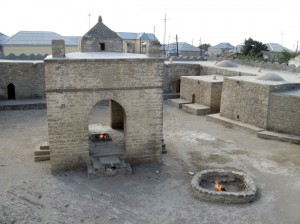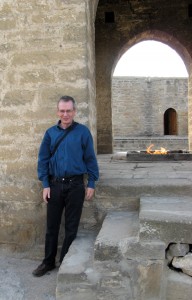 After failing to find a suitable bus, train, or marshrutska, I eventually took a taxi out to the Baku Atashgah (Fire Temple). The taxi driver chatted with me in weak English. He complained about government corruption and how there should be lots of money in Azerbaijan but it didn’t make it down to the people. He also complained that California’s Gubernator Schwartzenegger was far too sympathetic to the wicked Armenians. (Not an accusation I had previously heard!)
After failing to find a suitable bus, train, or marshrutska, I eventually took a taxi out to the Baku Atashgah (Fire Temple). The taxi driver chatted with me in weak English. He complained about government corruption and how there should be lots of money in Azerbaijan but it didn’t make it down to the people. He also complained that California’s Gubernator Schwartzenegger was far too sympathetic to the wicked Armenians. (Not an accusation I had previously heard!)
The Baku Atashgah or Fire Temple is a much larger complex than the Atashgah in Tbilisi, with a large courtyard surrounded by cells for visiting pilgrims. The central building, which houses the scared flame, is surprisingly similar in shape and dimensions to the Tbilisi Ateshga. However, here all four walls have open archways, rather than the closed archways of Tbilisi. There is also a small crematorium pit to the side.
 It is sometimes asserted that the site originated as a Zoroastrian temple which was destroyed by the Arabs, but apparently modern scholarship rejects this. In any event, the current structure was built in the early 17th c. by Indians with a strong emphasis on Vishnu, with his trident. (Which is a pity as the original Zoroastrian religious vision seemed much simpler and less superstitious.) The scared flame was originally fed by a natural gas vent, which, alas, expired in 1882, so it is now run off the municipal gas mains.
It is sometimes asserted that the site originated as a Zoroastrian temple which was destroyed by the Arabs, but apparently modern scholarship rejects this. In any event, the current structure was built in the early 17th c. by Indians with a strong emphasis on Vishnu, with his trident. (Which is a pity as the original Zoroastrian religious vision seemed much simpler and less superstitious.) The scared flame was originally fed by a natural gas vent, which, alas, expired in 1882, so it is now run off the municipal gas mains.
Nowadays the site has been restored purely as a tourist attraction, with waxworks figures in the pilgrim’s cells. The central flame was initially out, but after I paid my admission fee, the attendant discreetly turned on the gas .